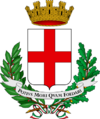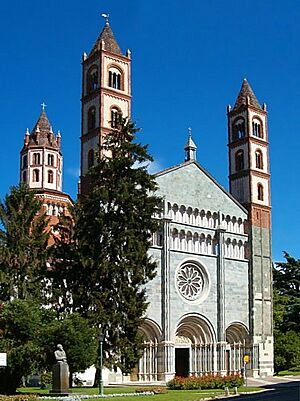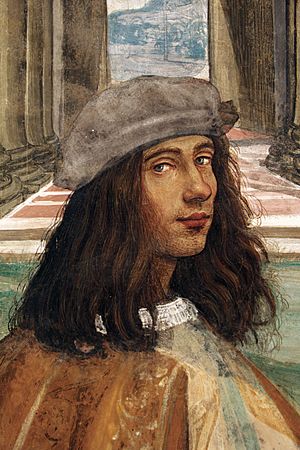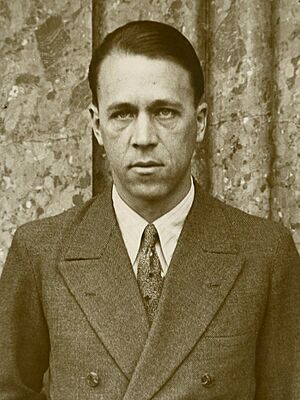Vercelli facts for kids
Quick facts for kids
Vercelli
Vërsèj (Piedmontese)
|
||
|---|---|---|
| Città di Vercelli | ||
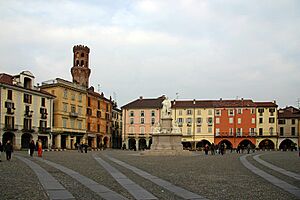
Piazza Cavour and the Torre dell’Angelo.
|
||
|
||
| Country | Italy | |
| Region | Piedmont | |
| Province | Vercelli (VC) | |
| Frazioni | Brarola, Cappuccini, Larizzate, Bivio Sesia, Boarone, Campora, Canton Biliemme, Carengo, Cascina Mostioli, Cascine Strà, Cominetti, Montonero | |
| Area | ||
| • Total | 79.77 km2 (30.80 sq mi) | |
| Elevation | 130 m (430 ft) | |
| Population
(1-1-2021)
|
||
| • Total | 45,875 | |
| • Density | 575.09/km2 (1,489.48/sq mi) | |
| Demonym(s) | Vercellese(i) | |
| Time zone | UTC+1 (CET) | |
| • Summer (DST) | UTC+2 (CEST) | |
| Postal code |
13100
|
|
| Dialing code | 0161 | |
| Patron saint | Eusebius of Vercelli | |
| Saint day | August 1 | |
Vercelli is an old and important city in northern Italy. It is located in the Piedmont region, on the Sesia River. The city is between two big Italian cities: Milan and Turin.
Vercelli is famous for growing rice. The area around the city is full of rice paddies that are flooded in the summer. The weather in Vercelli is usually cold and foggy in winter. Summers are hot. Most rain falls in spring and autumn.
People in Vercelli speak Italian. They also speak a local language called Piedmontese, specifically a version known as Varsleis.
Vercelli was home to the world's first university paid for by public money. It opened in 1228. Today, Vercelli has a university campus for literature and philosophy. It also has a part of the Politecnico di Torino, which is a technical university.
Contents
History of Vercelli
Vercelli, once called Vercellae, was the main city of an old tribe called the Libici. It became an important Roman town. A famous Roman general, Gaius Marius, won a big battle here in 101 BC. He defeated the Cimbri and Teutones tribes.
Later, around 500 years after Marius, another general named Flavius Stilicho defeated the Goths here. After the Lombard invasion, Vercelli became part of the Duchy of Ivrea. By 885, the city was ruled by its bishop.
Vercelli became an independent city in 1120. It joined important groups of cities called the Lombard Leagues. These leagues fought for freedom from emperors. In 1197, Vercelli made a law that ended serfdom. This meant people were no longer tied to the land they worked.
In 1228, the University of Pavia moved to Vercelli for a while. A famous religious leader named Fra Dolcino was executed here in 1307.
Over the years, Vercelli was controlled by different powerful families and rulers. These included the Della Torre family, the Marquesses of Monferrato, and the Visconti family from Milan. In 1427, Vercelli became part of the lands ruled by the dukes of Savoy.
Vercelli was captured by the French in 1499 and 1553. The Spanish also took it in 1616 and 1678. In 1704, the French tried to destroy its fortress but failed. Vercelli then stayed with Savoy. In 1821, the people of Vercelli supported a new constitution.
Main Sights in Vercelli
Vercelli has many old Roman things to see. These include parts of an amphitheater and a hippodrome (a track for horse races). You can also find old stone coffins and important writings from Roman times.
The city has seven interesting towers. The most important ones are the Torre dell’Angelo in the old market square and the Torre di Città.
The Vercelli Cathedral was built and made bigger by Saint Eusebius of Vercelli. It was changed a lot in the 1700s. Inside, you can see beautiful paintings by famous artists from Vercelli. These artists include Gaudenzio Ferrari and Gerolamo Giovenone.
The Cathedral has a special library with very old books. One book is the Codex Vercellensis, a religious text from the 300s. Another famous book is the Vercelli Book. This is an old English manuscript with a well-known poem called The Dream of the Rood. The city's old records go back to 882.
The Basilica di Sant'Andrea was built in 1219. It is one of the most beautiful and well-preserved Romanesque buildings in Italy. It stands next to an old Cistercian monastery. Another important church is the Santa Maria Maggiore.
Vercelli also has a synagogue at Via Foà 70. It is built in a special style called Moorish Revival architecture. The city's Jewish cemetery is nearby.
The Institute of the Beaux-Arts has paintings by local Vercelli artists.
Demographics of Vercelli
In 2007, about 44,475 people lived in Vercelli. Slightly more than half of the people were female. About 14% of the population were children and teenagers (under 18). About 25% were older people. The average age of someone living in Vercelli was 47 years old.
Between 2002 and 2007, the number of people living in Vercelli went down a little. Most people in Vercelli are Italian. Some people are from other countries like Albania, Romania, and North Africa. About 1 in 6 babies born in Vercelli has at least one parent from another country.
Museums in Vercelli
- Museo Camillo Leone
- Museo Francesco Borgogna
Notable People from Vercelli
- Eusebius of Vercelli (around 283 – 371): He was the first bishop of Vercelli and is considered a saint.
- Atto II of Vercelli (around 885–961): He became the bishop of Vercelli in 924.
- William of Montevergine (1085–1142): He was a traveler and founded several monasteries.
- Guala Bicchieri (around 1150 – 1227): A diplomat and a cardinal in the Catholic Church.
- Emilia Bicchieri (1238–1314): A Roman Catholic nun.
- Fra Dolcino (around 1250 – 1307): A leader of a reform movement.
- Giovanni Antonio Bazzi (1477–1549): A famous painter from the Renaissance period.
- Francesco Antonio Vallotti (1697–1780): A composer, music expert, and organ player.
- Giacomo Abbondo (1720–1788): A Roman Catholic priest.
- Eusebio Bava (1790–1854): An army general who fought in the First Italian War of Independence.
- Angelo Agostini (1843–1910): An illustrator and journalist, known as the first Brazilian cartoonist.
- Luigi Galleani (1861–1931): An anarchist in the US.
- Fiorenza Cossotto (born 1935): A famous opera singer.
- Angelo Gilardino (1941–2022): A composer and classical guitarist.
- Anita Caprioli (born 1973): A theater and film actress.
Sport Personalities
- Marcello Bertinetti (1885–1967): A fencer who won gold medals at the Olympics.
- Virginio Rosetta (1902–1975): A footballer who played many games for clubs and for the Italian national team.
- Silvio Piola (1913–1996): Another famous footballer with many club and national team appearances.
- Franco Bertinetti (1923–1995): A fencer who won team gold medals at the Olympics.
- Elisabetta Perrone (born 1968): A race walker who won multiple medals.
- Giovanni Pellielo (born 1970): A sport shooter and four-time Olympic medalist.
- Moise Kean (born 2000): A footballer who has played many club games and for the Italian national team.
Cuisine of Vercelli
A special dish from Vercelli is rice with beans, called panissa. It is made with local rice types like Arborio. For dessert, there's the tartufata cake and bicciolani biscuits.
The local wine is Gattinara DOCG. This is a red wine made from the Nebbiolo grape. People have been growing grapes in Gattinara since Roman times.
Sport in Vercelli
Unione Sportiva Pro Vercelli was a very successful football club in Italy. They won the national championship seven times between 1908 and 1922.
In 2010, the club had financial problems and could not play in the league. A new club, A.S. Pro Belvedere Vercelli, continued its history and changed its name to F.C. Pro Vercelli 1892. Today, the team plays in Serie C.
Twin Towns
Vercelli is twinned with these cities:
See also
 In Spanish: Vercelli para niños
In Spanish: Vercelli para niños
- Communes of the Province of Vercelli


